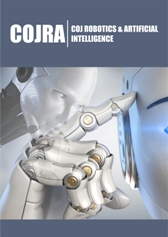- Submissions

Full Text
COJ Robotics & Artificial Intelligence
Modeling Stealing Madness Ratings using Artificial Intelligence Technique
Femi Temitope Johnson*
Department of Computer Science, Federal University of Agriculture, Abeokuta, Nigeria
*Corresponding author: Femi Temitope Johnson, Federal University of Agriculture, Abeokuta, Nigeria
Submission: October 01, 2024;Published: October 24, 2024

ISSN:2832-4463 Volume4 Issue2
Opinion
Artificial Intelligence (AI) is a welcome innovation in this 21st century. Its adoption towards solving different problems in various human endeavors and spheres of life is yielding significant results and improvements [1]. More importantly, in areas where well-known traditional, physical [2] and medical approaches have met with an abrupt end. AI techniques have not only proven to be very effective but also superior in generating the most precise and best solutions to problems [3]. This brief article reviews approaches used in stealing madness (kleptomania) diagnosis and proposes the components for modeling an Artificial Intelligence approach toward effective and accurate diagnosis.
Kleptomania is a psychological disorder that creates an irresistible urge in affected persons usually above the age of eighteen to steal worthless items (pins, match sticks, pencils, crayons, etc.) with a pleasurable sense of relief after the action [4]. The stolen items are always of no importance nor use to the “thief” but rather expose him/her to social stigmatization, psychological treatments, and legal actions of the law in society, psychiatric hospitals, and law courts respectively [5]. Stealing madness as a psychological disorder has no regard for gender or social status, its origin is traceable to the nineteenth century and presently has no confirmed nor approved drug for its cure. Thus, in a very short time from now it may be regarded as a neglected disorder with patients living to face its accrued consequences [6]. However, clinical studies, statistical surveys, etiology and diagnosis performed over the years revealed that anti-depressants or anti-convulsants combined with psychotherapy have varying degrees of minute success in managing the disorder [7]. Clinicians, scientists, psychologists and psychiatrists are still faced with the challenge of diagnosis and ambiguity in deciding the right management practices for patients suffering from Kleptomania.
The utilization of AI approaches has been very effective in diagnosing multiple physical
and mental ailments [8]. The proposed AI approach for modeling stealing madness diagnosis
may adopt the Fuzzy logic technique to generate a crisp value useable for classifying a patient’s
degree of kleptomania into three groups- Sporadic, Episodic and Chronic according to the
American Psychiatric Association (APA) classification to determine the best management
practice to be adopted. In addition, the different factors identified for the diagnosis of
kleptomania will be classified into three major categories namely: Patients Physical Attribute
(PPHA), Patients Psychological Attribute (PPSA) and Patients Social Status (PSOS). The
patient’s Physical Attribute (PPHA) would comprise the patient’s sex and age ranging from
eighteen years and above, patient’s Psychological Attribute (PPSA) would also consist of:
A. Impulse Level (IMPL): rated on a Clinical Global Impression (CGI) severity scale
administered through structured clinical interview.
B. Frequency of Action (FoA): the number of times or counts of theft incidents within a
week.
C. Presence of Concurrent Disorder (PCD): resulting from
alcohol, conduct, hormone or pelvic disorder.
Similarly, the Patient’s Social Status (PSOS) can be subcategorized into High, Middle and Low classes. A further check may also be performed to determine the extent of influence or relationship between Impulse level (ImL) and Frequency of Action (FoA). These fuzzy inputs with their respective linguistic variables should be assigned a membership function, fuzzified and passed into the inference engine which interacts with a knowledgebase containing sets of rules for diagnosis. A chosen method of defuzzification can be useful to generate a crisp value from the aggregated fuzzy set to appropriately diagnose and classify patients into the three groups mentioned earlier. Conclusively, a comparison of results from both approaches, the AI and the conventional approach (based on the Kleptomaniac Symptom Assessment Scale (K-SAS)) should be performed to reveal which method is more accurate, efficient, faster and minimizes human intervention [9].
References
- Johnson F, Oluwatobi O, Folorunso O, Ojumu AV, Quadri A (2022) Optimized ensemble machine learning model for software bugs prediction. Innovations Syst Softw Eng 19: 91101.
- Johnson FT, Akerele J (2020) Artificial intelligence for weed detection -a techno-efficient approach. ICTACT Journal on Image and Video Processing 11(2): 2299-2307.
- Saminu A, Folorunso O, Johnson F, Akerele J, Ilesanmi S, et al. (2022) Adaptive neuro-fuzzy model for vehicle theft prediction and recovery. Communications in Computer and Information Science 1547: 20-34.
- Kulandai Therese (2024) Kleptomania Disorder. International Journal for Multidisciplinary Research 6(2): 1-7.
- Rivanie SS, Soewondo SS, Azisa N, Abadi MT, Iskandar I (2022) The application of imprisonment to kleptomaniacs: A case studies of court decision. SIGn Jurnal Hukum 4(1): 113-123.
- Torales J, Gonzalez I, Castaldelli-Maia JM, Ventriglio A (2020) Kleptomania as a neglected disorder in psychiatry. Int Rev Psychiatry 32(5): 451-454.
- Simon KM, York T, Anglero YD (2020) Kleptomania: 4 Tips for better diagnosis and treatment. Current Psychiatry 19(8): 44-45.
- Gupta N, Singh H, Singla J (2022) Fuzzy logic-based systems for medical diagnosis-A Review. 2022 3rd International Conference on Electronics and Sustainable Communication Systems (ICESC), Coimbatore, India, pp. 1058-1062.
- Sipowicz J, Kujawski R (2018) Kleptomania or common theft-diagnostic and judicial difficulties. Psychiatr Pol 52(1): 81-92.
© 2024 Femi Temitope Johnson. This is an open access article distributed under the terms of the Creative Commons Attribution License , which permits unrestricted use, distribution, and build upon your work non-commercially.
 a Creative Commons Attribution 4.0 International License. Based on a work at www.crimsonpublishers.com.
Best viewed in
a Creative Commons Attribution 4.0 International License. Based on a work at www.crimsonpublishers.com.
Best viewed in 







.jpg)






























 Editorial Board Registrations
Editorial Board Registrations Submit your Article
Submit your Article Refer a Friend
Refer a Friend Advertise With Us
Advertise With Us
.jpg)






.jpg)














.bmp)
.jpg)
.png)
.jpg)










.jpg)






.png)

.png)



.png)






